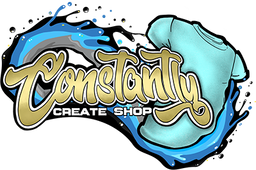Screen printing, also known as Silk screen printing, is a "printing technique where a mesh is used to transfer ink (or dye) onto a substrate, except in areas made impermeable to the ink by a blocking stencil." It is one of the earliest methods of printing, and it is used in many forms of decoration till this day. Screen printing offers many low-cost options, especially for higher quantity projects. In our industry, Screen printing is best used for 1-2 color artwork, but can range up to 6 or more colors depending on the artwork.
This print method offers us the ability to price a project out based on simple factors that are easily understandable. First, the quantity of garments being printed is the biggest question. In higher quantities, Screen printing is by far the lowest cost option for any type of custom apparel from t-shirts to hoodies. You typically see screen printed items at places like sporting events, schools, and other large order companies where they tend to have more simple artwork and higher quantity of items, helping keep their costs as low as possible. Next, the quantity of colors within the artwork would be the next variable that can change the cost of a screen printed project. The less colors in the artwork, the better price you will get on your project. For each color in the artwork, it requires additional setup time and materials and adds to the overhead of the run. Keep that in mind when choosing artwork for your next job! Lastly, the garment being printed matters. When printing a t-shirt, vs. a hoodie, or when printing a thin polyester shirt vs. a thick fleece shorts, different temperature and cure times of the ink are required as well as additional additives into the ink to make sure the consistency of the print is at the quality standards we are expecting during decoration.

One of the topics that we often discuss with clients when going over Screen printing would be ink Pantone colors. Pantone colors allow us to match an ink color exactly to a specific brand color way, and lets us consistently get that color every time we need. It is important to go over colors in person, because not all colors we see on our device screen will look the same. For example, if we look at this orange mixed ink on our phone or tablet, it will likely look different if we open it up in a web browser on a computer. Why? Because all of our devices are showing colors based on their screens display capabilities. Pantone colors allow the custom apparel industry an option to keep consistency in this process.
A day in the life of a Screen printing operator starts out by making sure their area is clean and prepared for the next project. Curing screens, mixing ink, and reclaiming screens are parts of the process that you don't normally see, but that are getting done in the background. These steps in the process are important parts to the overall cost of a project because their is only one setup, so if you get 24 shirts vs 1000 shirts, the cost for each shirt decreases as the quantity gets higher since the project is already set up and on the press. Keep this in mind during your next Screen print quote!

One of the most interesting and common upgrades we do here at Constantly Create Shop would be 3D Puff Screen printing. This method of customization takes a regular ink, gets an additive mixed in, and with some changes to the cure temperature and time, once the print goes through the conveyor dryer to cure, the ink rises up like bread in a bakery oven. To master 3D Puff Screen printing requires a lot of skill and patience. Each climate has different settings to get this right, but when completed the right way, the finished product stands out like no other. This is how you can take a simple piece of artwork and make it look premium with a minor added cost (usually just 1 added color, so a 2-color print would be priced as a 3-color print).
Lastly, Screen printing requires different setup to get started. We have to make screens, one for each color being used in the artwork and one just for the under base white ink if the print is going on a dark garment. If your ink colors change for different sets of garments, we have to rinse out the screens to apply the new ink. We set up separations for each layer of ink, so that the mesh covers the right area of the garment needed for decoration. So, while the cost of a Screen printed shirt might only be a few dollars, there are setups that are charged to cover the cost of overhead to get the project ready to press. Your best option is to provide vector based artwork, which will help keep the cost of setup as low as possible. The more artwork and preparation our team has to do, the more it will cost. In the long run, for re-orders, these costs aren't charged again unless there are changes made to the artwork, or if the project hasn't been ran in the last 6 months.
Overall, Screen printing is best for higher quantity runs with a low amount of colors in the artwork. This will help keep your costs down, and get the project finished sooner.

